I recently came back from a research trip to Nevada where I was able to revisit Michael Heizer's Double Negative(1969-1970). I had not seen the work for almost ten years and I was curious to explore how both the work and myself had changed during that time. The work is currently in the collection of the Museum of Contemporary Art in Los Angeles (MoCA). By writing this essay I wanted to emphasize how important it is for institutions like MoCA to continue to exist and that their support for making information available about these projects is invaluable. Each Land Art project is a unique and individual experience. As our thinking about the potential of art, our environmental awareness, and our understanding of the complex eco-systems of these sites have evolved over the last 40 years, so have the works themselves. The works have gone through a process of continuous transformation in an extreme environment. Most of the Land Art projects currently exist somewhere between the artist's original conception and a raw natural state becoming both something more and less of what they were at the time of their creation. What exists for us now in revisiting these sites might be very different than the inspiration that these works provided when they were first created. As we approach the 40th anniversary of the creation and conceptions of some of the major Land Art projects, the purpose of the essay is to reconsider the original explanations and analysis of these works and examine what these works might suggest for us today.
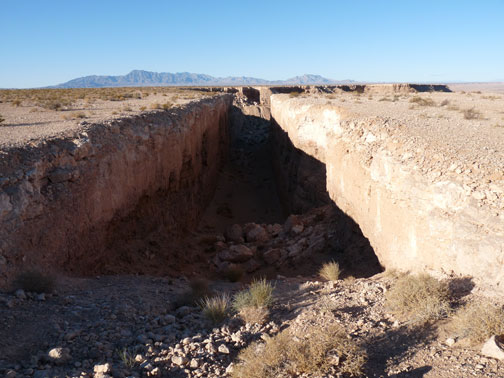
Double Negative in the late afternoon
Like most things in life, it always takes you a little longer to find it than you had anticipated. I was driving across the top of Mormon Mesa, outside of Overton , Nevada, looking for Michael Heizer's Double Negative. Double Negative was conceived in 1969 and completed in 1970. Incredibly, Heizer was only 24 years old when it was completed. I had been to Double Negative a couple of times about ten years earlier. I lived in Las Vegas at the time and experiencing the work changed my life. I suppose in some way, I am still trying to come to grips with what I had experienced during those trips.
As I am driving along the road, I was happy that it was well maintained and the progress to the work much easier than I had expected. I had remembered the road being much rougher and slower. I checked one valley and then another, always checking the scalloped edges of the mesa for a geometry that was rectangular and therefore a little misplaced among soft curves of the mesa itself. One valley was much too small and the next seemed much too large for the work to exist. It was interesting to be able to examine the raw edges of the mesa and it helped me understand a little bit better Heizer's remarkable transformation of the raw material of the desert itself. I could see the way the Virgin River, even though it was a couple of hundred feet below, was slowly eroding the edges of the material of the cliffs as the mesa was slowly pulled down to the river. It was a process of slow transformation and had probably been going on for thousands of years. Most of the time the process is probably very gentle, but occasionally there must be cataclysmic transformations as large sections of the mesa give way.
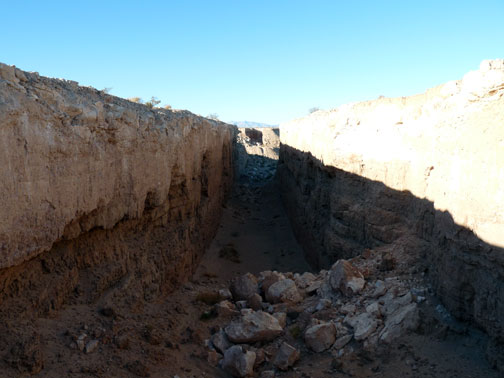
On the slope walking into Double Negative
In the third valley, I had finally found what was I looking for, two large excavations on opposite sides of the mesa. There were no signs or wall labels. It was just me, the work and the desert. Heizer did not add anything to the site, his genius is in what he took away. He did not use anything that did not exist there in the first place. His process was to reveal what existed but was hidden and to make the to make the structure, mass and the space of the mesa visible. After revisiting a few of the sites and seeing how they have been transformed over time, there is a definite need to critically reevaluate the significance of the earth works and Land Art projects most of which were built in the late sixties and early seventies. The condition of these works is unique and have often been 40 years in the making. By re-evaluating what existed when the work was completed by the artist and what exists now, we can learn a lot about how the work and ourselves have transformed over the last 40 years.
Most of things that we have learned about Land Art usually present the work as being extensions of Minimalism and that the work's monumental size is a more of a tribute to the artist's ego rather than to the environment in which they are placed. I would disagree on both counts. Most discussions about Minimalism tend to stress the formal and visual aspects of works by artists like Donald Judd or Richard Serra. In reality, I think that these artist were less interested in how something looks and more interested in the way that the work related to the space where the work was located. The aesthetic and formal aspects of the works were clearly secondary if they were given any importance at all. In Heizer's case, the language of the work developed from working with the raw materials of the desert itself and were conceived to give the viewer a much more direct connection to one's awareness of being in the desert. The forms were secondary and the size was more indicative of the possibilities of the site rather than a preconceived idea about size or scale. I wonder if the misperceptions have lasted so long because it is very difficult to come to terms with a work that is radically different from any work that we might experience in a gallery or museum. One of these things that are completely different about these works is that they are still transforming. They are still in a state of becoming. The artist's initial conception of the work is only the framework in which the natural process of nature: wind, rain, gravity and erosion have contributed to make the work that we now experience. In contrast to Land Art and De Kooning's paintings aside, Pollock's painting are more or less what they were 50 years ago. The painting isn't still changing. It is fixed and stable (more or less). The museums in which they are located work very hard to keep them way. Land Art is often more transient because it is placed in a much more extreme environment and the material used to make the work is often the materials found at the site. The result is that the artist's idea was just the beginning of the work rather than the end. These works will continue to grow and change so long as there is enough marks or alignments that exist to provide legibility of the artists original intentions.
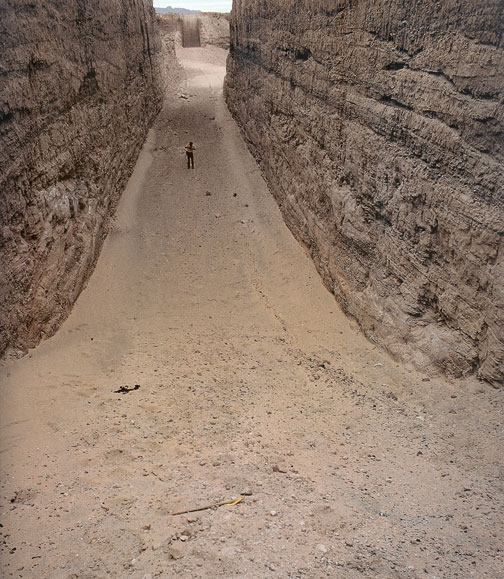
Double Negative soon after completion
When Heizer went out to the edge of Mormon Mesa in 1970 his tools were a bulldozer, dynamite, probably a survey kit and a crew talented and brave enough to be able to make his conception a reality. He received funding for the lease of the land and support for the construction costs by the gallery owner Virginia Dwan. At the time the cost of the work was about $9,000. The work itself is two channels cut into opposite sides of the mesa. Each channel is approximately 15 meters deep and 9 meters wide. The western cut is about 230 meters long while the west cut is a shorter 100 meters long. Approximately, 244,800 tons of sand stone and rhyolite were relocated to make the work. The work is so large that there is not really an equivalent in the history of Western Art. It is longer than the Empire State Building is tall. When I was looking for the work and I was examining some of the valleys on the road to Double Negative, I was impressed with the fragility of the edge of the mesa. The edges are, after all, in a constant state of erosion. After the work had been marked, it must have taken an extremely brave person to make the first cut, maybe 6" or a 1' deep, and push it off the edge of the mesa. The drop off is extremely steep. There was no guarantee that the bulldozer would not just the follow the material off the edge of the mesa if the edge had given way and fallen down toward the river below. Everyone must have been holding there breaths because there would have been no way to know if the edge could support the weight of the bulldozer until they tried it. As work progressed it probably got a little easier and any large rocks that could not have been removed by the bulldozer would have been dynamited. After approximately, two weeks the excavations of the cuts were complete and the Heizer's initial conception of the work was complete.
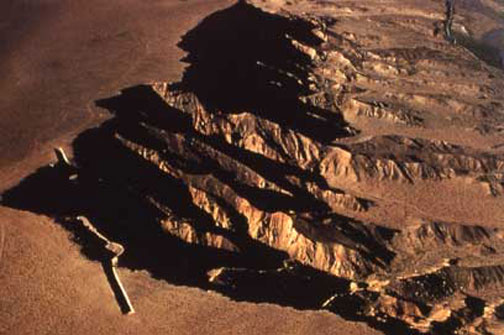
Double Negative from the air
One of the things the reasons that most Land Art projects are not properly understood, or even widely discussed, is because the tools and methods that these are artists were using are not available to us today. Forty years later, we have a different understanding of the fragility of the desert than the artists, and society, did in the sixties. Rather than being a wide open, empty space we see it is an incredibly old and subtle ecosystem that needs to be understood and protected rather than being blown up. So clearly, the tools and strategies that Heizer were able to use to make the work would not be applicable today. We have changed. Because we would not be able to recreate the work in our time, does that mean that there is nothing for us to learn or rediscover about Double Negative? No. I think that there is perhaps more for us to learn from Double Negative now than when it was originally completed. This highlights the big difference between Land Art and most other kinds of art work.
When the work was completed in 1970, the work was fulfillment of Heizer's initial conception of the work. Everything was completed to his specifications. Anything that interfered with the articulation of the work was removed either by dynamite or bulldozer. The work was imposed on the desert. It was a negation of the original state of the desert because it had to find a way to differentiate itself surrounding desert of the mesa. The work by definition, if it was to be visible, was the opposite of nature. If nature was random, the work was order. If nature was shallow, the work would be deep.
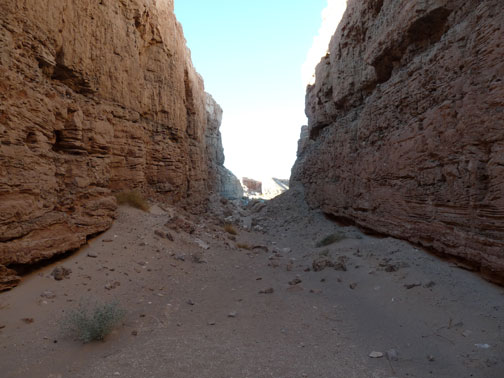
Inside Double Negative
All of these contrasts allowed the work to become legible but its legibility was always in opposition rather than integration to the natural state of the mesa. Forty years, later the desert has moved back in to reclaim the void that existed in the work. The overall form of the work, because so much of the work is based on the experience of the large volume of space, is slowly being undermined as the walls erode and material falls into the cuts. In other words, the work is transforming from Heizer's clear idea about a volume of space excavated into the mass of the mesa into something else, something more in tune with the processes that shaped the mesa in the first place. In addition, Heizer's original cuts have been continually re-excavated by the natural processes of erosion. The work has become a continuation of the Heizer's process of excavation but through natural rather than mechanical means. This is the big difference with Land Art; Heizer's idea, his excavation, was just the beginning of the work rather than its end. Its completion is postponed indefinitely as it is slowly overwhelmed with the natural processes of the desert. Each year the work becomes something else, revealing itself a little bit more by demonstrating a little bit more the transformation of the mesa itself. What began as a negation of the desert, has become a window into the geological strata and the processes of erosion that pulls the mesa toward the river.
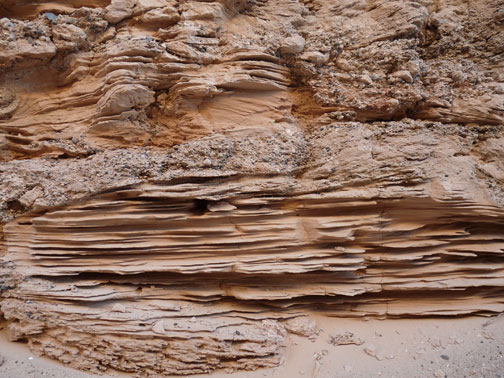
Nature's re-excavation of Double Negative
Surprisingly for a work that is created as two cuts or two negative spaces in the mesa, the work itself is experienced like an object. Not only do two negatives make a positive, but it is experienced in a subtle way as a clearly defined space. The experience of the work is the experience of the space of the excavation. Other artists at the time were experimenting with different ways of the articulating the experience of a work as a relationship rather than as an object. When you see Double Negative, one is inevitably matching two equivalent spaces that align on opposites sides of the mesa. It is the void of the valley itself that allows the two sides of the work to seem to be connected as a single piece. This is especially apparent in aerial views of the work. The cuts seem to read as one continuous band or object. On the ground, the experience is a little different. The work exists as a cross section of the mesa. Heizer's cuts reveal and display the layers of rock and sediment that have accumulated over million years to create the mesa itself. The up close understanding of these layers would have been nearly impossible without Heizer's work. It is one of the many contradictions of Double Negative. Heizer's unnatural act of using dynamite and the bulldozer to create the work allows the geology and erosion within the work reveals the mesa in a totally unexpected way. The work becomes a natural extension of the processes of the mesa itself. The unnatural becomes natural and the more time that passes, the more natural it becomes. It is the unique relationship between the excavations and the valley itself that reveals this extraordinary dichotomy of the natural and the unnatural that is interwoven within the experience of the work.
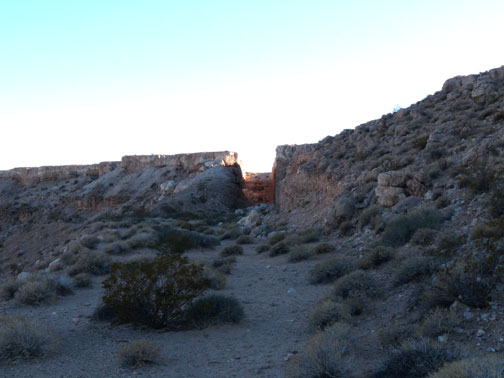
Looking back at one of the cuts
Although most of the photos of Double Negative are taken from within the excavation themselves, nearly a the third of the work was created in the way that the debris from cuts was pushed out into the valley. The natural void of the valley is extremely important to the experience of Double Negative and reveals itself in unexpected ways. First, Heizer understood that the material that was being excavated from the cuts had to go somewhere. It might have been piled up on the mesa itself but the better solution, and the one he chose, was to allow that debris to continue into the space of the valley and form its own line. From a practical level, it allows the work to be constructed in the first place. The valley allows each of the excavations to be separate units while still being part of a coherent whole. On a conceptual level, the void of the valley separates the two cuts and paradoxically allows their perceived connection. The work transforms from two stable, rectangular volumes of negative excavated into the solid mass of the mesa and becomes progressively less defined as it extends into the void of the valley itself. In other words, the entire space of the valley becomes essentially incorporated into the space of the work. The space of the work is increased exponentially as it grows from the relatively small size of the cuts to the immeasurable space of the entire valley. Third, the excavations do not connect as there is a dramatic transformation as the lines of the bulldozers ends and we are confronted with the natural slope of the mesa moves toward the river. Even on foot it is nearly impossible to make the journey from one side of the work to the other. What seems connected and of a single unit from the air becomes framed, focused but disconnected from the ground. The journey from one cut to the other is nearly always made by climbing up the slope at the back of the cut and walking along the flat mesa to get to the other side. The valley, the void, is uninhabitable and the connection from one side of the work to the other becomes transcendental because it exists for our eyes and mind rather than our bodies. As we gaze from one side of the mesa, we start with the man made, enter the space of the valley, and end again with the man made. It is the alternating rhythm of the unnatural, natural and then the unnatural again that informs our experience and allows us to make a direct connection to desert itself. The natural and unnatural are linked and the work becomes a window in the desert itself. The entire work becomes a way for us to come to a deeper understanding of our place the desert. It allows the awareness of ourselves to extend to the environment of the work. Double Negative is completely integrated and inseparable from the environment in which it is located.
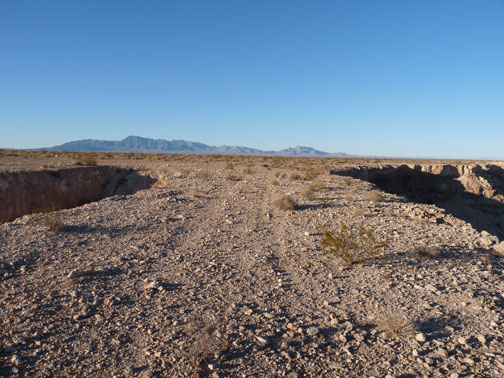
From certain views, Double Negative is almost indistinguishable from
the forms created by the natural process of erosion on the mesa.
Another difference between Land Art and work that is often experienced in a museum or a gallery, is the way that the boundaries of a work in the desert often extend to the boundary of the desert itself. In the case of painting, the edges of a canvas creates a natural boundary that takes place within it. The paintings of Clyfford Still aside, anything that exists within those boundaries is automatically related to edges of the canvas. Double Negative is an inversion of the traditional relationship between the boundary and the frame. First, the work exists as a clearly defined excavation that exists on two side of the mesa. If we were to try and determine the boundary of the work, we might run into trouble because there is not a simple answer. One way to ask the question would be to say that if Double Negative reveals the geological layers of the entire mesa, how much of the surface of the mesa then is necessary to establish the boundaries of the excavations? In other words, where does the work stop? Would 1' be enough? Or how about 50'? As you go on, you realize the boundary of the work becomes the boundaries of our perception of the mesa itself. The boundary itself is massive but necessarily indeterminate. This is why the situation with the proposed drilling in the Great Salt Lake would have created a big problem for the experience of Spiral Jetty. Even if the drilling was still miles away, if you could see it, it would change the way that we would experience the work.
This is why visiting these Land Art projects is so rewarding because the experience of the work is inseparable from your experience of the place. Everything becomes an extension of the work because there is no clear boundary when the work starts and stops. Is it really so different when you are driving for 30 minutes across the mesa looking for the work and examining the natural features of the landscape is than when you are walking through Heizer's excavations? They are both intrinsically part of the same place and there is no way tell when one experience stops and another begins. For me, driving along the dirt road to get to the work is as much a part of the work as stumbling down the slope to traverse the cuts themselves. The experiences run together. Like I said at the beginning, when you see the work there are no signs or descriptions, you define and create your own experience. What you get out the work is whatever you put into your experience. Without making a value judgment, either you see the work and feel the connection to the site or you don't. You are completely on your own. The transformation of these work makes visiting these sites exhilaratingly because you realize you are changing along with the work.
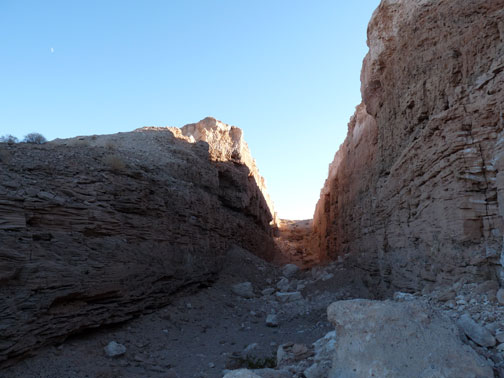
Double Negative revealling the natural slope between Mormon Mesa and
the Virgin River below
The options and strategies that were used by these artists might not be available to us today but we have the advantage of seeing how 40 years of exposure to wind and rain of the desert have transformed and changed these works. The works have become a collaboration between the artists idea and the way desert has moved to reclaim the land. I do not think that there is an equivalent to the transformation of these works or even the long term collaboration between artists and nature in the entire history of art. Surprisingly, the work that exists for us now is not necessarily the same work that artist had in mind when they completed the project in the first place. In other words, the experience of these works is unique to our time. The works are constantly recreated themselves and they are a little different each time. The edges of Double Negative have been softened, and the steep vertical lines of the excavations are slowly being equalized through a steady process of erosion but these processes reveal an experience that have been developing for the last 40 years. Works like Double Negative have become windows in the processes of nature that they often negated during their creation. These pieces as they now exist have been decades in the making, revealing their state of continuous transformation. The artist's original intention was only the starting point. Issues of time and transformation can be explored in these works in ways that would be impossible for traditional work in a museum. These works in their current state provide excellent models in the way that current artists can work with the natural processes of nature rather than in opposition to it because we have the benefit of seeing how these works change over time. In other words, the natural transformations of these work provide the beginning rather than the end of the experience.
Hi Matt,
Thanks for your nice comments.I think that you are right that having Double Negative in the collecition of MoCA is a somewhat uneasy fit, especially if one of the best things about visiting these works is that there is no admission booth, cafe or bookstore. It is just you and one work.
Your observation does raise an interesting point. I think that there was time in late sixties and early seventies where people where expecting museums to commission more land art works. There was the opportunity to have the museum to become more like a facilitator rather than a depository.
At the time, a lot of people thought that these works were threatening the idea that art has to be an object based commodity. In other words, this work was attacking the core foundations of the art market. The work was seen as a kind of undermining the status quo.
Dave Hickey talks a lot about this in his excellent article Earthscapes, landworks and Oz that was written for Art in America in 1971. Besides being one of my favorite pieces of writing, he does a very good job of outlining the relationship between what these works mean for the traditional art world. Ultimately, he does not see a conflict but others saw this work as a threat.
So perhaps the amibivalence that you feel towards having Double Negative in the collection of MoCA might also be shared by the museum itself. Perhaps they see the work as a historical artifact rather than actually relevant to contemporary artists and worth promoting.
Experiencing these works in their environment is very different than looking at art in museum or gallery. They have the ability to transform your values and make you rethink what is important about art.





























![[TypeKey Profile Page]](http://www.portlandart.net/nav-commenters.gif)